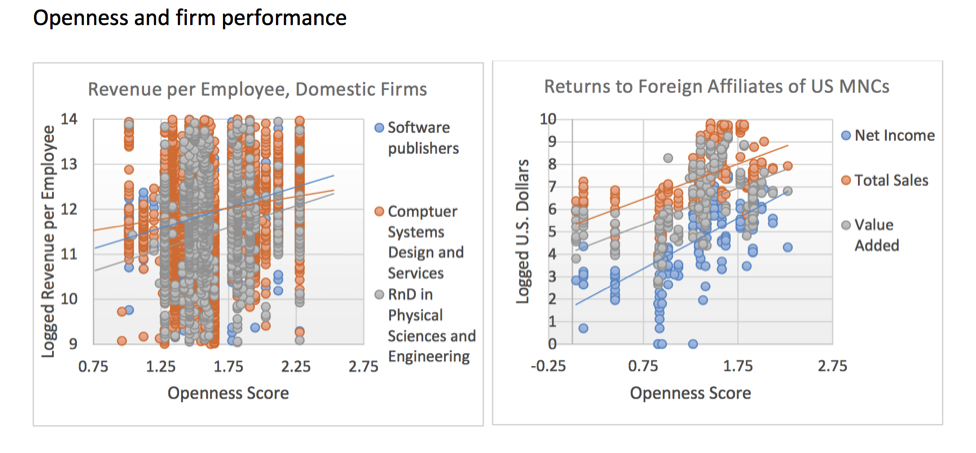Evidence Continues to Show Benefit of “Openness” in Copyright Regimes
Copyright limitations and exceptions like fair use and fair dealing positively contribute to economic growth and innovation and are relied upon by a diverse representation of industries. Numerous studies (including but not limited to [1] [2] [3] [4]) continue to drive this point home, most recently with a forthcoming study, previewed this week, by the Program on Information Justice and Intellectual Property (PIJIP) that concluded “open” fair use-type laws benefit innovation, creativity, and foreign direct investment.
The study (full report on file with author), The User Rights Database: Measuring the Impact of Copyright Balance, compiled and evaluated a database of middle income and high income countries’ changes to copyright limitations and exceptions from 1970 to 2016. The report observed that the “openness” of a country’s copyright regime is positively related to economic development and creativity within the country. “Openness” refers to copyright limitations and exceptions that apply to any kind of work, by any kind of user, for any purpose. This was represented on a scale from 0-3, where a score of 0 represented that a law had no element of “openness” and a score of 3 represented that the law “clearly” had elements of “openness” (for example, a quotation right that was open for any type of user, to any work, for any purpose).
Based on the results (illustrated in the charts above taken from the report), U.S. firms operating abroad reported higher income, an increase in total sales, and an increase in value added in host countries with more “open” copyright practices. Internet services and software publishers also specifically benefitted. The data shows these industries that rely on copyright limitations and exceptions reported higher revenues in countries with more “open” limitations. A particularly illuminating data point of the report showed that a one-unit increase in the “openness” score is associated with a 50%-70% increase in revenue, even controlling for firm size, country wealth, country size, and time.
Further, the report also concluded that data shows no negative relationship between “openness” of copyright limitations and the revenues of book publishers, music publishers, or motion picture and video productions. Rather, the data suggests there is a significant positive relationship (though the report does not seek to draw conclusions with respect to why there is a positive relationship). This is complementary to another recent report showing that fair dealing in Canada is not tied to declines in educational publishing revenue.
Studies like these that illustrate the role balanced copyright plays in economic growth report are critical to consider as the United States reviews its trade priorities. Trade incentivizes countries to adopt laws analogous to the U.S. framework, encouraging foreign direct investment by industries that rely on limitations and exceptions. This is important because few countries and almost no developing countries have sufficient balance in their copyright laws necessary to support domestic innovation and create a sustainable digital economy. Incorporation of such balanced copyright protections will open international markets for U.S. industries. As the evidence shows, both openness and IPR enforcement mechanisms are essential to attracting investment and should be considered of equal priority when negotiating trade agreements.
As DisCo has argued in its ongoing series [1] [2], the renegotiation of the North American Free Trade Agreement (NAFTA) provides a key opportunity for the United States to set the new model of modern trade agreements by incorporating commitments to promote balanced copyright policies. This includes keeping critical safe harbor protections for online intermediaries (Jonathan Band expands upon the importance of keeping safe harbors in the renegotiated agreement and maintaining the “grand bargain” between the content industry and online intermediaries here).
It is of further interest to U.S. industry that USTR push for “openness” commitments and fair use-like limitations and exceptions pursuant to U.S. law in the renegotiated NAFTA. This is not a novel position for the U.S. to take. The final text of the most recently negotiated trade agreement, the Trans-Pacific Partnership, provided in Article 18.66: “Each Party shall endeavour to achieve an appropriate balance in its copyright and related rights system, among other things by means of limitations or exceptions … giving due consideration to legitimate purposes such as, but not limited to: criticism; comment; news reporting; teaching, scholarship, research, and other similar purposes.” The U.S. should go one step further in NAFTA 2.0 to mandate similar commitments to “openness” in copyright regimes in order to foster growth among trading partners.









